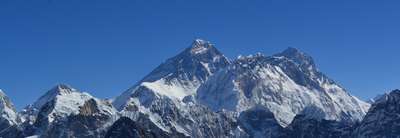In the footsteps of Nepal's Maoist rebels, Guerilla Trek
In the footsteps of Nepal's Maoist rebels
Trail-blazing visitors trek through former war zones, staying with villagers once terrorized by Maoist insurgents
By Julia Horton 23 March, 2011
Top of Form
Where guerrillas used to roam, tourists now trek.
For 10 years gun-toting Maoists prowled Nepal's remote Himalayan trails dodging attacks from army helicopters.
Today, five years after a peace accord ended the insurgency, tourists armed with cameras and water purification tablets are following in the rebels' footsteps.
Where once guerrillas greeted trekkers at gunpoint with demands for cash, Maoists in former no-go zones now shake visitors warmly by the hand and offer to show them around.
The so-called Guerrilla Trek -- an 11-day hike across central and western Nepal -- is part of Nepal Tourism Year 2011, the latest drive in the Himalayan republic aimed at opening up new areas to double international visitor numbers to a million by 2012.
Guesthouse owner grandmother Tulsara Pun, 64, used to live in fear of Maoist guerrillas.
Trapped in the middle
Villagers readily talk about their years of torment under the Maoist shadow.
Tulsara Pun's wizened face speaks of years of hardship. The 64-year-old sighs wearily, leaning on a table and lighting another cigarette as she recalls the regular death threats she received while her village resembled a battlefield.
"It was very hard for us, very frightening -- the army were on one side, the Maoists on the other [of the village] so we were stuck in the middle," she says.
"We had no choice, we had to give things to them or they threatened to hurt us. People were killed here."
Miming shooting someone, she adds: "They said 'If you don't give us food this is what we will do to you.'
"The Maoists came out of the trees with machine guns and said they wanted food and blankets."
Nowadays, most of Tulsara's trade comes from local people but she is eager to welcome trekkers, saying: "We would like moretourists to come here and stay with us.
Also on CNNGo: Bluffer's guide to Asia
"The Maoists said they would pay for food sometimes but they never did. Then the army would come and demand to know why I had given food to the Maoists."
Dhapalal Pun, 37, rebuilding his home in Thabang which was destroyed during the insurgency.
Tourism replacing war
There have never been many tourists in this area, and the few groups that do come generally camp, bringing all their equipment with them.
Thabang, in Nepal's north, was the cradle of the revolution and suffered some of the worst devastation as the army repeatedly bombed the guerrillas' power base in deadly night raids.
The damage is still visible today. Teenagers play volleyball beside piles of rubble which were once homes.
The red flag flying above the village and slogans daubed in the same color suggest that Maoists still dominate here.
But a new poster on a guesthouse wall advertising Nepal Tourism Year 2011 illustrates locals' desire to use their revolutionary past to secure a share of their country's growing tourism industry.
Dhapalal Pun, 37, who has an eight-year-old son and a daughter of 13, sits quietly breaking stones with a hammer outside his front door.
Also on CNNGo: What makes Nepal so special?
He is still rebuilding his family's old home after it was destroyed during the war. Luckily nobody was hurt as he and his family were visiting relatives in another village at the time.
But his face clouds as he recalls the constant terror every night.
Two young girls on the Guerrilla Trek route in western Nepal. Most youngsters were unable to go to school during the conflict.
Return of peace
"I remember the sound of the army helicopters overhead and the fear we all had," says Dhapalal.
"We felt in great danger. Bombs landed all around, we would wake up to the sound and be so scared. Many people were killed."
The return of peace has made a huge difference to children as it is now safe for them to return to school.
Youngsters run up and down the trail and calls of "Namaste!" are frequent. Some offer unexpected variations on the greeting, including "Hello darling!"
The path is also used by women and children carrying vast piles of straw and baskets of dung for fuel.
Tourists may witness Hindu funeral celebrations in the villages along the trail.
Groups of armed men still lurk in the shadows of the forests here, but today they are hunters, their victims mountain goats, not people.
getting there
For details of the Guerrilla Trek visit Swiss Nepal Family Trekking at www.nepaltrekking-online.com
Read more: In the footsteps of Nepal's Maoist rebels | CNNGo.com http://www.cnngo.com/explorations/life/trek-434749#ixzz1IjnXuQit







